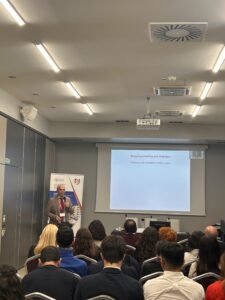During the Less Harmful Coalition Summit in Toronto(Canada, October 2022), Dr. Renée O’Leary, CoEHAR researcher, presented her study about two methods for identifying policy narratives, using as example e-cigarette policy documents: the SCHEER of the European Union and the Report from Canada.
Starting from the important document signed by 67 professors, “Critical appraisal of the European Union Scientific Committee on Health, Environmental and Emerging Risks (SCHEER) Preliminary Opinion on electronic cigarettes” published in 2021, Dr. O’Leary explained two methods to identify policy narratives: the content analysis and the narrative policy framework.
Based on the content analysis, Dr. O’Leary showed as the SCHEER Reports omitted from the terms of reference “tobacco harm reduction” and alludes to a “resurgence of cigarette smoking” suggesting a renormalization of smoking. Something that is not actually happening, as clearly shown by the accelerated decline in smoking prevalence in EU member states. Moreover, the opinion states that EU prevalence’s of ENDS use are “increasingly rising”. But this is not true – says the expert. ENDS usage prevalence has been relatively stable between 2017 and 2019. From a careful analysis emerges that:
- 7 members states experienced a very small increase in prevalence: 0.2% or less
- 3 members states had no rise
- Only 2 states had increase in prevalence of 1%
- The highest ENDS prevalence are between 4.1 and 5.7% in 8 member states;
- Prevalence is under 2% in 13 member states.
In Canada, the report made 27 claims about e-cigarettes, among the most important:
- May pose health risks;
- Use of e-cigarettes in places where smoking is banned;
- The addictive nature of nicotine;
- A gateway effect for youth in particular;
- A risk to the efforts and successes in tobacco control.
“Vapour devices may expose users to health risks” – ”Vapour devices could impede tobacco control” but not all countries were the same.
QLD claims focused on untrustworthy, youth use, and tobacco control, EU majority of claims of exposing users to health risks and US focus on unsafe products, user health risks, youth appeal, poisonings, and dual use.

“Policy narratives are socially constructed stories produced within belief systems that narrate the reality of the policy problem and assign blame. The purpose of policy narratives is persuasion, to influence the framing of a policy problem and shape policy beliefs – said dr. O’Leary – So long as the narratives in the state arena about vapour devices are only stories of threats, any potential opportunity vapour devices may offer for tobacco harm reduction is automatically lost“.




